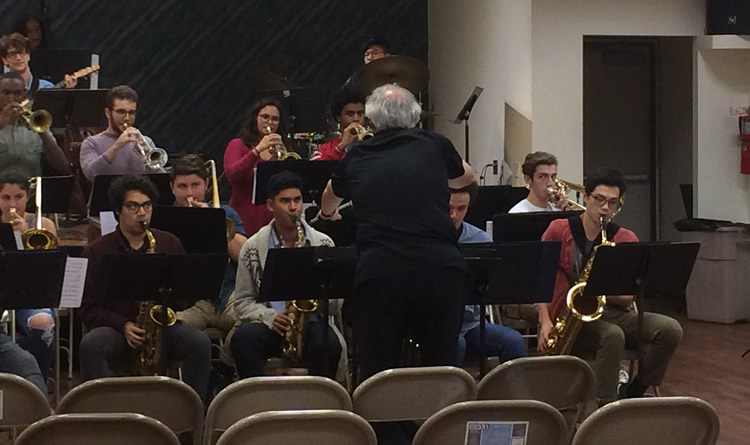Allegro
The Next Generation of Swing
Volume 118, No. 1January, 2018

The LaGuardia High School Jazz Band under the direction of Local 802 member Kevin Blancq performed for a recent clinic led by Ed Joffe (on the podium, above). Photo: Bettina Covo
For most musicians, achieving a successful career is about setting goals and accomplishing them – mastering an instrument and perfecting your craft, creating positive momentum in your career, and attaining a certain level of employment or professional status. When the Council for Living Music together with Music for a Sound Future decided to present a high school jazz band clinic, one of the goals was to provide as many high school students as possible a top-notch jazz clinic in the hallowed halls of Local 802.
Earlier this fall, the Council for Living Music accomplished just that. Three high school jazz bands from the greater New York metropolitan area descended on the club room of Local 802 to participate in Learning Live: A Count Basie High School Band Clinic led by multi-woodwind instrumentalist and music educator Ed Joffe.
Prior to the actual clinic, each band was assigned a specific piece of classic Count Basie repertoire, giving the bands a month with the material. At the clinic, each group was allotted an hour, during which time they played through their piece with their respective director, followed by a critique and instruction from Ed Joffe that focused on particular facets of style and performance.
The first band to perform was Mount Olive High School Jazz Band from Flanders, N.J., directed by Darrell Hendricks. They performed Frank Foster’s “Blues in Hoss’ Flat.” After a lively rendition, replete with plenty of solos, Joffe examined the various musical elements singular to the Basie tradition. Focusing primarily on the rhythm section and the way the horns relate to it, Joffe systematically worked with the piano, bass, drums and guitar, coaching them on style and approach. Joffe pointed out, “It is important to get a balanced rhythm section to support the rest of the band. In Basie’s rhythm section, less is more.” By the end of their session, the band’s performance was more cohesive and more in the groove as the students strived to achieve that Basie sound.
Next to the stage was the Herricks High School Band from New Hyde Park, N.Y., under the direction of Geoffrey Taylor. The band deftly performed “It’s Oh, So Nice,” by Sammy Nestico. This band meets after school one evening every week and therefore learned their assigned chart with only four rehearsals.
Joffe’s focus for this group was on the quality of sound generated by the horns and the importance of maintaining energy throughout any piece in order to drive the music. To emphasize that point, the trumpet section and eventually all of the horn players were instructed to sing their individual parts, something the students found difficult to do. Joffe explained, “If you can’t sing it, you can’t play it.” He discussed the all-important basics of rhythm and tempo as the sections worked on specific passages in the piece. Joffe told them, “To make it swing, you have to play in the pocket with a relaxed precision.” The end result was an improved performance as they alternated singing and then playing a phrase.
Finally, the LaGuardia High School Senior Jazz Band, directed by Local 802 member Kevin Blancq, performed the classic “Corner Pocket” by Freddie Green (arranged by Ernie Wilkins) with great aplomb. After their initial performance of this work, Joffe presented a very interesting exercise for the students – he gave the band an arrangement of a J.S. Bach chorale in the same key as the chart (Db). Parts were handed out and the band sight-read the chart, a fairly literal rendition of Bach’s harmonization. Joffe worked with them section by section, stressing the importance of tuning and blending. After a few passes, the band was clearly more comfortable with this approach and then played the chart for the final time. Their sound and quality was stunningly different. It was cleaner and more resonant. Joffe said, “Playing a Bach chorale like this forces you to listen better. Everything is open and exposed, written largely with triads and passing dissonances, so you can understand how your particular note relates to everyone else’s and thereby tune better. Taking that back to your jazz work can only help to improve the ensemble.” And that it did. When they returned to “Corner Pocket,” suddenly the group sounded more in tune with each other with a greatly improved ensemble blend. The students heard it, the audience heard it, and their band directors heard it.
In addition, the clinic was peppered with snippets of jazz history plus recordings and films of early Basie performances, all to illustrate the rich, vibrant quality of top professionals from the original bands performing these great charts.
The clinic was a huge success on all levels. The students were given a unique opportunity to perform for an audience of over 70 peers and friends, professional musicians and the general public – a learning experience in and of itself. Ed Joffe, one of New York’s finest educators and knowledgeable jazz clinicians, offered each band unique techniques to help improve their performances. The band directors had the occasion to meet one another and share their teaching experiences. And finally, for the Council of Living Music and Music for a Sound Future, it was a rare occasion where over 50 young music students performed and made music together under the Local 802 roof. As one director enthusiastically put it, “We need to have more of these. This was wonderful!”
Goal accomplished.
